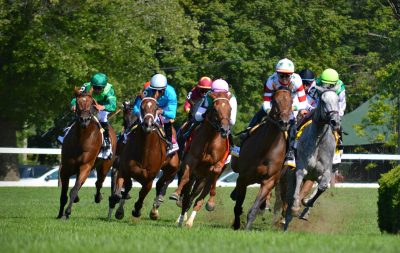By Noel Michaels
Blink and you’ll miss it. While horseplayers look forward to the start of the big summer meets at Saratoga and Del Mar in the next week or two, we all will be treated to a special bonus week of top-class racing at the unlikeliest of summer venues – Keeneland.
Keeneland’s special one-week summer meet will run five days from July 8-12. By running this brief meet, Keeneland will manage to salvage 10 of its original 15 spring graded stakes races. That’s amazing when you consider the five-day meet will probably run a total of only about 55-60 races, meaning that more than 15 percent of all the total races run at the entire meet will be graded stakes.
All 10 graded stakes will be run in a three-day period from July 10-12, including the Blue Grass (G2) on Saturday, July 11, and all four original spring G1 races – the Ashland on July 11, the Madison on July 11, the Maker’s Mark Mile on Friday, July 10, and the Jenny Wiley on July 11.
Since Keeneland’s ultra-boutique summer season lasts only one week handicappers better start brushing up now on some of the things they need to know to some fast cash.
Trainers to watch
In terms of the human connections expected to come out on top at Keeneland, the short meet should fall into some sort of no-man’s land in-between what you would normally see at the spring meet, which was canceled this year, and what you would usually see at the fall meet.

Chad Brown – Photo Courtesy of NYRA
Mike Maker was the leading trainer at last fall’s Keeneland meet with eight wins, followed by Chad Brown with seven victories. Several others had good seasons at Keeneland’s most recent meet last October, including Brad Cox, Wesley Ward and Ian Wilkes with five wins apiece. At last year’s spring meet, Ward was the leading trainer with 11 wins, followed by Cox with 10 and Brown with nine. Todd Pletcher won five of 14 starts (36 percent).
Because of its proximity to this year’s Belmont and Saratoga seasons, the top trainers at Keeneland this summer could look a lot different. This is especially true with the likes of Brown and Pletcher, who are expected to focus their attention on Saratoga and will be less prominent than usual at Keeneland, except in stakes races, where they are always major factors.
Steve Asmussen, Mark Casse, and Graham Motion also may see decreased presence at Keeneland this season for the same reason.
The absence of much of the above-mentioned trainers’ top stock, except in stakes, is likely to lead to a big week for other trainers such as Cox and Ward, who should be battling it out for leading trainer, along with Robertino Diodoro, who was leading trainer at Oaklawn and has continued to regularly win at a high percentage.
Diodoro was already prominent at Keeneland’s fall meet last year, where he scored four wins from only 13 starters (31 percent). Peter Miller should also be a factor, especially after bringing eight starters to Keeneland last fall and winning with four of them.

Horse Racing – USR Photo
Inside speed may be the way to go
From a handicapping perspective, historically, Keeneland was always known as an inside speed paved highway. Speed and the rail? Gold. That all changed during Keeneland’s Polytrack era, but mainly, that good old rail has returned on the main track. The No. 1 post can be expected to win at around 20 percent in dirt sprints and up to 25 percent in dirt routes. Horses seem to have a fair chance in sprints all the way out to post 11, with inside, middle, and outside posts all offering fair win percentages. In two-turn dirt route races at a mile or more, horses can also win from any part of the starting gate, but overall, the inside posts 1-5 give a horse the best chance.
As far as the preferred Keeneland main track running styles, horses have their best chances to win by staying within two lengths of the lead at the first call in sprints, and within four lengths of the lead at the first call in routes. Front runners do best at 6 furlongs (20 percent wire-to-wire and 33 percent of the winners on or close), and at 1 1/16 miles, also with about 20 percent wire-to-wire winners.
One great angle to look for at Keeneland involves cutbacks in distance. Horses cutting back in distance from a race at a mile or longer last time out into a sprint during Keeneland are better bets than they are almost anywhere else. Particular trainers to watch for with this angle include Dallas Stewart, Motion, and Wilkes.
The other main staple of the quality day-to-day racing at Keeneland is the great turf racing, which features big full fields, tons of value, and loads of good overlays.
Post positions could be key in turf races
Post positions and horses for the course are very important handicapping factors on the Keeneland grass course, and this factor will play out throughout the meet.
In turf routes, inside posts are good, but middle posts are also fine all the way out to post 7. The far outside posts, however, are not great at most distances on the Keeneland grass. Based on a large sample size in turf routes run at Keeneland since the fall of 2014, various posts 1-7 all yield between 10-14 percent winners, but the outside posts average far worse. The worst turf races for outside posts will definitely be at one mile, and the absolute worst posts for all turf routes at Keeneland are posts 10 and outward. At one meet a few years ago, those posts combined to go 0-for-47. They have been only slightly better ever since.
One thing that differentiates Keeneland from so many other places is that they routinely run on wet turf courses that are listed as yielding or something other than firm. Don’t overlook these softer turf courses when looking for value, because they are often a source of some of the best long shot payoffs at the meet.
Handicappers in these races often make the mistake of paying too much attention to a horse’s recent form while ignoring perhaps what really matters in many of these cases – the course condition. What it often boils down to is whether or not the horse can run its best race on yielding or soft turf courses. Remember that certain horses like firm turf while others prefer a little bit of give in the ground. If you can differentiate between the two, you will have a big advantage over the general public in the races run on softer turf courses.

Noel Michaels has been involved in many aspects of thoroughbred racing for more than two decades, as a Breeders’ Cup-winning owner and as a writer, author, handicapper, editor, manager and promoter of the sport for a wide range of companies including Daily Racing Form and Nassau County Off-Track Betting.
He also is regarded as the leading source of news and information for handicapping tournaments and the author of the “Handicapping Contest Handbook: A Horseplayer’s Guide to Handicapping Tournaments”, which made his name virtually synonymous with the increasingly-popular tournament scene.
In addition to contributing to US Racing, he is also an analyst on the Arlington Park broadcast team.


